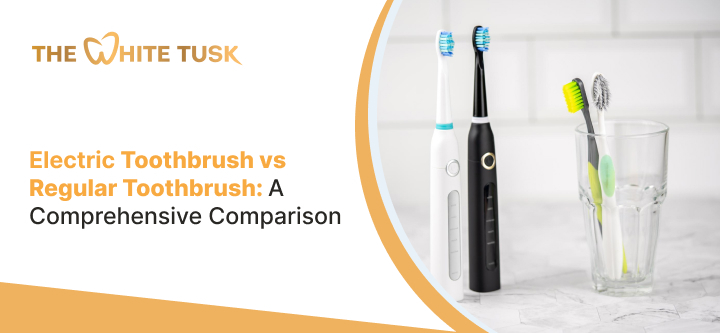
Are you still trying to figure out if an electric toothbrush is better than a manual one? You’re not the only one! Many people wonder which is the better choice for their oral care routine. In this blog, we’ll compare electric and regular toothbrushes, looking at the pros and cons of each to help you make the right pick for your teeth.
| Feature | Electric Toothbrush | Regular Toothbrush |
| Cleaning Efficiency | High; powered by oscillating or vibrating bristles | Moderate; relies on manual brushing technique |
| Ease of Use | Simple; minimal hand movement required | Requires controlled hand movement and technique |
| Cost | Generally more expensive | Affordable; wide price range |
| Battery/Power Requirement | Yes; requires batteries or charging | None; always ready to use |
| Recommended For | People with limited mobility, orthodontic braces, or gum issues | Those who prefer low-cost, manual control |
| Environmental Impact | Higher due to batteries and electronic components | Lower due to simpler materials |

Electric toothbrushes often come with oscillating, vibrating, or rotating heads designed to remove plaque more effectively than manual brushing. Studies have shown that electric toothbrushes can reduce plaque by up to 21% and gingivitis by 11% after three months of consistent use.
Electric toothbrushes do a lot of the work for you. The consistent motion reduces the effort required to brush, which is particularly beneficial for:
Many electric toothbrushes feature built-in timers to ensure you brush for the recommended two minutes, as well as pressure sensors to prevent brushing too hard, which can damage enamel and contribute to gum recession or tooth resorption.
Electric toothbrushes are generally more expensive than regular ones, and prices vary widely based on features. Replacement brush heads also add to the cost, making this option less budget-friendly.
Due to their electronic components, electric toothbrushes have a higher environmental footprint. Battery disposal and the materials used in electric toothbrushes are less eco-friendly than traditional manual toothbrushes.

A regular toothbrush is cost-effective and widely available. It offers an affordable solution for effective cleaning for those on a budget or with limited dental supplies.
Manual toothbrushes give users complete control over their brushing speed and pressure. Those skilled in proper brushing techniques can clean their teeth as effectively as they would with an electric toothbrush, although this requires consistency and focus.
The effectiveness of a regular toothbrush relies entirely on technique. Improper brushing can lead to ineffective cleaning, plaque buildup, and even tooth and gum damage.
Unlike electric toothbrushes, manual brushes lack timers, pressure sensors, and other features that guide optimal brushing habits. This makes it easier to brush too hard or too quickly, increasing the risk of dental issues like enamel wear and gum recession.
For those with a history of tooth resorption, gum recession, or other dental sensitivities, an electric toothbrush with a pressure sensor may be the better choice. For those with healthy teeth and gums, a regular toothbrush may suffice, provided it’s used with proper technique.
Consider whether you’re willing to make an upfront investment in an electric toothbrush and commit to regular head replacements. While a regular toothbrush requires only occasional replacement, the long-term costs may even out depending on individual dental needs.
Regular toothbrushes typically generate less waste than electric ones. Some companies also offer recyclable or biodegradable options for manual toothbrushes, appealing to eco-conscious users.
An electric toothbrush may simplify dental routines for those with busy schedules. However, for minimalists or travelers, a manual toothbrush offers simplicity and portability without the need for charging.
Choosing between an electric toothbrush and a regular toothbrush depends on personal needs, budget, lifestyle, and specific dental health concerns. While electric toothbrushes offer advanced features, superior cleaning power, and ease of use, regular toothbrushes are cost-effective and environmentally friendly. For users with conditions like tooth resorption or sensitivity, an electric toothbrush may offer added protection with built-in features like pressure sensors.
Still, have questions about which toothbrush is right for you? Drop your queries in the comments 👇, and we’ll be happy to help!
Electric toothbrushes tend to be more effective due to their consistent motion and vibration, which can help remove plaque from hard-to-reach areas.
While they don't "prevent" gum disease on their own, electric toothbrushes can improve plaque removal and reduce gingivitis when used correctly.
Yes, electric toothbrushes can be more effective for people with braces, as they help remove plaque around brackets and wires.
Both electric and regular toothbrushes should be replaced every 3–4 months or sooner if the bristles are frayed.
I used to be suggested this website by my cousin. I’m
not positive whether or not this publish is written by
waay of him as nobody else recognize such specified about my problem.
You’re incredible! Tank you! http://boyarka-inform.com/